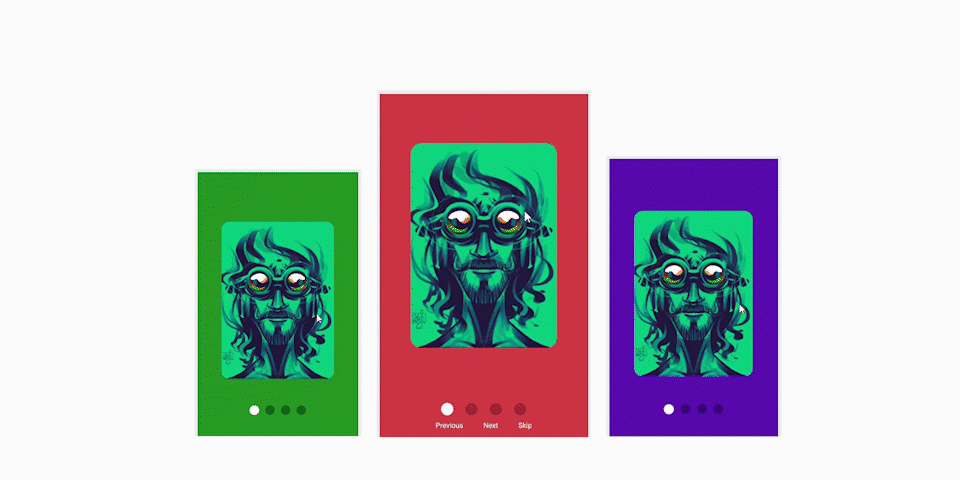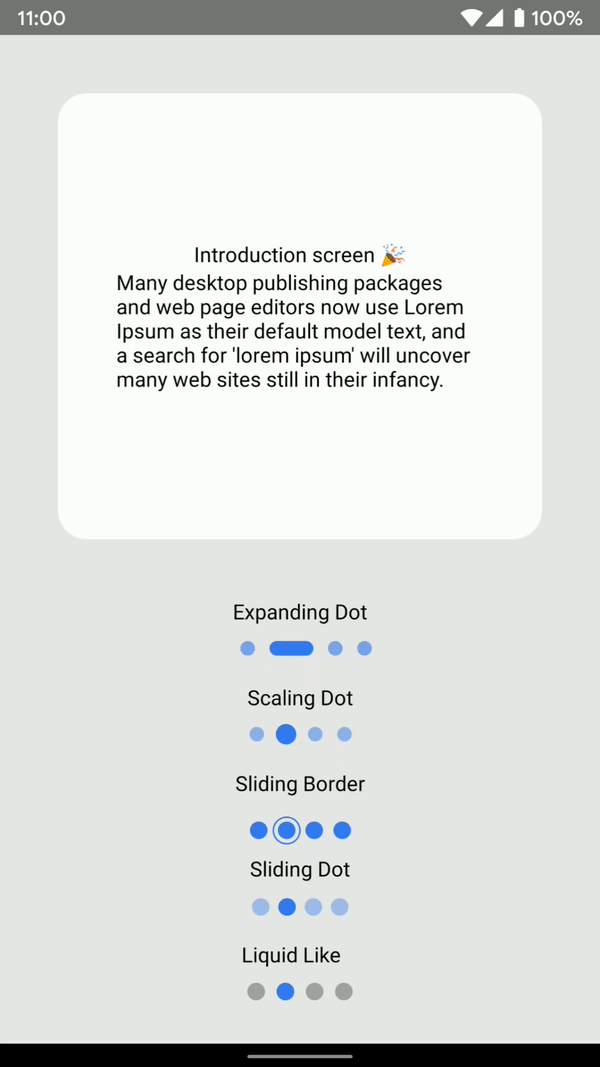
Security News
38% of CISOs Fear They’re Not Moving Fast Enough on AI
CISOs are racing to adopt AI for cybersecurity, but hurdles in budgets and governance may leave some falling behind in the fight against cyber threats.
react-native-animated-pagination-dots
Advanced tools


FlatList animated pagination dots. Some (maybe all) ideas and credits goes to Catalin Miron 👏.
This package does not use any dependencies but Animated API.
Now uses react-native-svg for the LiquidLike
Few days ago I made a reddit post, and people requested to open source it.
For more Copy & Paste stuff, go check example folder
npm install react-native-animated-pagination-dots
yarn add react-native-animated-pagination-dots
For the ViewPager, check their own repo
import {ExpandingDot} from "react-native-animated-pagination-dots";
const SLIDER_DATA = [
{
key: '1',
title: 'App showcase ✨',
description:
'Lorem Ipsum is simply dummy text of the printing and typesetting industry.',
},
{
key: '2',
title: 'Introduction screen 🎉',
description:
"Many desktop publishing packages and web page editors now use Lorem Ipsum as their default model text, and a search for 'lorem ipsum' will uncover many web sites still in their infancy. ",
},
];
const scrollX = React.useRef(new Animated.Value(0)).current;
<FlatList
data={SLIDER_DATA}
keyExtractor={keyExtractor}
showsHorizontalScrollIndicator={false}
onScroll={Animated.event(
[{ nativeEvent: { contentOffset: { x: scrollX } } }],
{
useNativeDriver: false,
}
)}
pagingEnabled
horizontal
decelerationRate={'normal'}
scrollEventThrottle={16}
renderItem={renderItem}
/>
<ExpandingDot
data={SLIDER_DATA}
expandingDotWidth={30}
scrollX={scrollX}
inActiveDotOpacity={0.6}
dotStyle={{
width: 10,
height: 10,
backgroundColor: '#347af0',
borderRadius: 5,
marginHorizontal: 5
}}
containerStyle={{
top: 30,
}}
/>
import React from 'react';
import {
StyleSheet,
View,
Dimensions,
Animated,
TouchableOpacity,
Text,
StatusBar,
} from 'react-native';
import { LiquidLike } from 'react-native-animated-pagination-dots';
const { width } = Dimensions.get('screen');
const data = [
{
image:
'https://cdn.dribbble.com/users/3281732/screenshots/13661330/media/1d9d3cd01504fa3f5ae5016e5ec3a313.jpg?compress=1&resize=1200x1200',
backgroundColor: '#7bcf6e',
},
{
image:
'https://cdn.dribbble.com/users/3281732/screenshots/11192830/media/7690704fa8f0566d572a085637dd1eee.jpg?compress=1&resize=1200x1200',
backgroundColor: '#4654a7',
},
{
image:
'https://cdn.dribbble.com/users/3281732/screenshots/9165292/media/ccbfbce040e1941972dbc6a378c35e98.jpg?compress=1&resize=1200x1200',
backgroundColor: '#7370cf',
},
{
image:
'https://cdn.dribbble.com/users/3281732/screenshots/11205211/media/44c854b0a6e381340fbefe276e03e8e4.jpg?compress=1&resize=1200x1200',
backgroundColor: '#db4747',
},
];
const imageW = width * 0.7;
const imageH = imageW * 1.4;
const ButtonNavigation = () => {
const scrollX = React.useRef(new Animated.Value(0)).current;
const keyExtractor = React.useCallback((_, index) => index.toString(), []);
//Current item index of flatlist
const [activeIndex, setActiveIndex] = React.useState(0);
let flatListRef = React.useRef(null);
const gotoNextPage = () => {
if (activeIndex + 1 < data.length) {
// @ts-ignore
flatListRef.current.scrollToIndex({
index: activeIndex + 1,
animated: true,
});
}
};
const gotoPrevPage = () => {
if (activeIndex !== 0) {
// @ts-ignore
flatListRef.current.scrollToIndex({
index: activeIndex - 1,
animated: true,
});
}
};
const skipToStart = () => {
// @ts-ignore
flatListRef.current.scrollToIndex({
index: data.length - 1,
animated: true,
});
};
//Flatlist props that calculates current item index
const onViewRef = React.useRef(({ viewableItems }: any) => {
setActiveIndex(viewableItems[0].index);
});
const viewConfigRef = React.useRef({ viewAreaCoveragePercentThreshold: 50 });
const renderItem = React.useCallback(({ item }) => {
return (
<View style={[styles.itemContainer]}>
<Animated.Image
style={{
width: imageW,
height: imageH,
borderRadius: 20,
resizeMode: 'cover',
}}
source={{ uri: item.image }}
/>
</View>
);
}, []);
return (
<View style={[styles.container]}>
<StatusBar hidden />
<View style={[StyleSheet.absoluteFillObject]}>
{data.map((item, index) => {
const inputRange = [
(index - 1) * width,
index * width,
(index + 1) * width,
];
const colorFade = scrollX.interpolate({
inputRange,
outputRange: [0, 1, 0],
});
return (
<Animated.View
key={index}
style={[
StyleSheet.absoluteFillObject,
{ backgroundColor: item.backgroundColor, opacity: colorFade },
]}
/>
);
})}
</View>
<Animated.FlatList
ref={flatListRef}
onViewableItemsChanged={onViewRef.current}
viewabilityConfig={viewConfigRef.current}
data={data}
renderItem={renderItem}
keyExtractor={keyExtractor}
showsHorizontalScrollIndicator={false}
pagingEnabled
horizontal
decelerationRate={'normal'}
scrollEventThrottle={16}
onScroll={Animated.event(
[{ nativeEvent: { contentOffset: { x: scrollX } } }],
{
useNativeDriver: false,
}
)}
/>
<LiquidLike
data={data}
scrollX={scrollX}
dotSize={18}
dotSpacing={6}
lineDistance={7}
lineHeight={4}
inActiveDotOpacity={0.2}
activeDotColor={'#fff'}
containerStyle={{ flex: 1 }}
/>
<View style={[styles.buttonContainer]}>
<TouchableOpacity
style={[styles.button]}
onPress={() => gotoPrevPage()}
>
<Text style={[styles.buttonText]}>Previous</Text>
</TouchableOpacity>
<TouchableOpacity
style={[styles.button]}
onPress={() => gotoNextPage()}
>
<Text style={[styles.buttonText]}>Next</Text>
</TouchableOpacity>
<TouchableOpacity style={[styles.button]} onPress={() => skipToStart()}>
<Text style={[styles.buttonText]}>Skip</Text>
</TouchableOpacity>
</View>
</View>
);
};
const styles = StyleSheet.create({
container: {
flex: 1,
justifyContent: 'center',
alignItems: 'center',
},
itemContainer: {
flex: 1,
width,
justifyContent: 'center',
alignItems: 'center',
},
buttonContainer: {
flexDirection: 'row',
},
button: {
margin: 20,
fontWeight: '700',
},
buttonText: {
color: '#fff',
},
});
export default ButtonNavigation;
| Name | Type | Default | Description |
| inActiveDotOpacity | number | 0.5 | In active dot opacity |
| expandingDotWidth | number | 20 | Active dot width |
| data | Array<Object> | required | Array which is used for flatlist iteration |
| scrollX | Animated.Value | required |
Gestures, like panning or scrolling, and other events can map directly to animated values using Animated.event(). For example, when working with horizontal scrolling gestures, you would do the following in order to map event.nativeEvent.contentOffset.x to scrollX (an Animated.Value) |
| dotStyle | ViewStyle |
width: 10, |
Basic styling for each dot. |
| containerStyle | ViewStyle |
position: "absolute", |
Basic styling for dots container. |
| Name | Type | Default | Description |
| activeDotScale | number | 1.4 | Active dot scale number |
| inActiveDotOpacity | number | 0.5 | In active dot opacity |
| data | Array<Object> | required | Array which is used for flatlist iteration |
| scrollX | Animated.Value | required |
Gestures, like panning or scrolling, and other events can map directly to animated values using Animated.event(). For example, when working with horizontal scrolling gestures, you would do the following in order to map event.nativeEvent.contentOffset.x to scrollX (an Animated.Value) |
| dotStyle | ViewStyle |
width: 10, |
Basic styling for each dot. |
| containerStyle | ViewStyle |
position: "absolute", |
Basic styling for dots container. |
| Name | Type | Default | Description |
| dotSize | number | 12 | Each dot size !IMPORTANT Do not adjust dot size through dotStyle, otherwise it'll misbehave |
| marginHorizontal | number | 3 | Margin between dots !IMPORTANT Do not adjust dot margin through dotStyle, otherwise it'll misbehave |
| data | Array<Object> | required | Array which is used for flatlist iteration |
| scrollX | Animated.Value | required |
Gestures, like panning or scrolling, and other events can map directly to animated values using Animated.event(). For example, when working with horizontal scrolling gestures, you would do the following in order to map event.nativeEvent.contentOffset.x to scrollX (an Animated.Value) |
| dotStyle | ViewStyle |
backgroundColor: '#347af0', |
Basic styling for each dot. |
| containerStyle | ViewStyle |
position: "absolute", |
Basic styling for dots container. |
| slidingIndicatorStyle | ViewStyle |
backgroundColor: '#347af0', |
Basic styling for Sliding indicator dot. |
| Name | Type | Default | Description |
| dotSize | number | 24 | Each dot size !IMPORTANT Do not adjust dot size through dotStyle, otherwise it'll misbehave |
| borderPadding | number | -5 | Padding between dot and border. Should be good between -5 and 3, test it out. |
| data | Array<Object> | required | Array which is used for flatlist iteration |
| scrollX | Animated.Value | required |
Gestures, like panning or scrolling, and other events can map directly to animated values using Animated.event(). For example, when working with horizontal scrolling gestures, you would do the following in order to map event.nativeEvent.contentOffset.x to scrollX (an Animated.Value) |
| dotStyle | ViewStyle |
backgroundColor: '#347af0' |
Basic styling for each dot. |
| containerStyle | ViewStyle |
position: "absolute", |
Basic styling for dots container. |
| slidingIndicatorStyle | ViewStyle |
borderWidth: 1, |
Basic styling for sliding bordered dot style. |
| Name | Type | Default | Description |
| dotSize | number | 12 | Each dot size |
| dotSpacing | number | 3 | Margin between dots |
| inActiveDotOpacity | number | 0.5 | In active dot opacity |
| inActiveDotColor | string | #000 | In active dot color |
| activeDotColor | string | #347af0 | Active dot color |
| data | Array<Object> | required | Array which is used for flatlist iteration |
| scrollX | Animated.Value | required |
Gestures, like panning or scrolling, and other events can map directly to animated values using Animated.event(). For example, when working with horizontal scrolling gestures, you would do the following in order to map event.nativeEvent.contentOffset.x to scrollX (an Animated.Value) |
| lineHeight | number |
4 |
Line height for sliding dot |
| lineDistance | number |
8 |
Line travel distance between dots |
| containerStyle | ViewStyle |
flexDirection: "row" |
Basic styling for dots container. |
See the contributing guide to learn how to contribute to the repository and the development workflow.
MIT
FAQs
FlatList animated pagination dots
We found that react-native-animated-pagination-dots demonstrated a not healthy version release cadence and project activity because the last version was released a year ago. It has 1 open source maintainer collaborating on the project.
Did you know?

Socket for GitHub automatically highlights issues in each pull request and monitors the health of all your open source dependencies. Discover the contents of your packages and block harmful activity before you install or update your dependencies.

Security News
CISOs are racing to adopt AI for cybersecurity, but hurdles in budgets and governance may leave some falling behind in the fight against cyber threats.

Research
Security News
Socket researchers uncovered a backdoored typosquat of BoltDB in the Go ecosystem, exploiting Go Module Proxy caching to persist undetected for years.

Security News
Company News
Socket is joining TC54 to help develop standards for software supply chain security, contributing to the evolution of SBOMs, CycloneDX, and Package URL specifications.